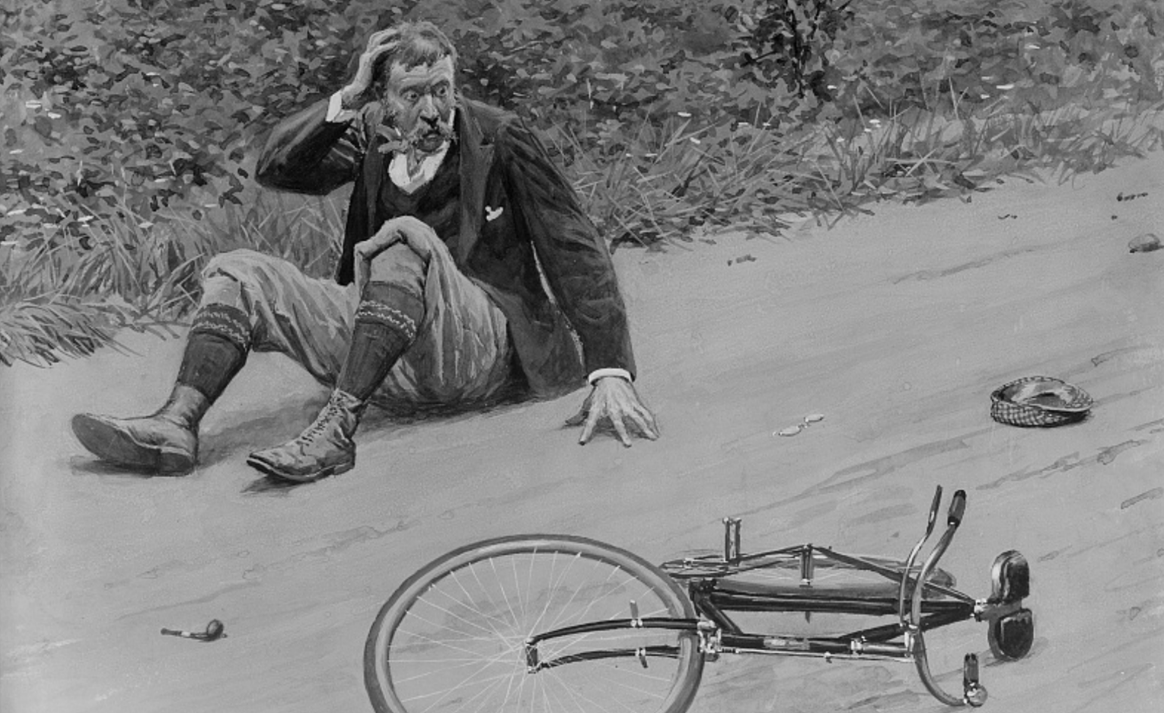Two-wheeled terror and the "Back to the Future" of personal electric vehicles

Welcome to the iCover Blog Pages ! Among the Geektimes articles, one can often find references to the book of the British publicist Alvin Toffler, “Shock of the Future.” Although the book was written back in the 1970s, it has not lost its relevance today.
We are familiar with historical examples when individual communities “overtook the future” - this is Singapore in the 70s of the XX century, and mobile communications between tribes in Africa and other cases when a group isolated from the achievements of civilization was “acquainted” with achievements civilization. Do you think this happened only on the outskirts of civilization? Not at all. Today we’ll tell you why you shouldn’t be afraid of personal electric transport, because once people instead of them feared ... bicycles!
In fact, concerns aboutpersonal electric vehicles and the panic that arose around the first bicycles has a lot in common. Look at newspaper headlines 136 years ago:

New York Times publication, June 11, 1880
Like electric scooters, the bike was not based on new technology. But then for many people the bike felt like a real innovation! He was quick and maneuverable. And therefore very scary. Governments around the world have seen this threat. The situation is the same with gyro scooters. The British banned bicycles on the sidewalks using the law of 1835, and you know what? Driving on scooters on the sidewalk in the UK is prohibited - based on the same law.
In 1881, bike lovers went to court to protest the ban on bicycles in Central Park in New York City. They lost a lawsuit in court, perhaps because witnesses believed that bicycles were two-wheeled terror.

Publication in the New York Times, July 15, 1881.
If a cyclist was involved in the accident at that time, he was most often recognized as the culprit. In 1880, the New York Times published material entitled “Bicycle Victim,” although the cause of the tragedy for the young girl was a fatal blow to the horse. The cause of the tragedy was a heart attack? And then the bike is to blame!

New York Times Publication, April 9, 1887
A few years later, the head of the US Army draft committee in Chicago refused to accept several cyclists. Dr. Stanton said that those who like to ride fast figuratively "burn out", and therefore are unsuitable for military service, the reason for their unsuitability is "bicycle hearts."
Later, fear was replaced by a sharp hostility - and it is not necessary to follow examples in the United States. For example, the newspaper “World Illustration” wrote about cyclists in Kiev in 1895: “The driver often turns the horses in front of the cyclist’s nose or pushes him to the right. In both cases, the cyclist is in serious danger . ” Meanwhile, the cabmen demanded to oblige all cyclists to overtake their wagons exclusively on the right side! The ban on cycling in Kiev was lifted only in 1891.
The movement of bicycles was legally regulated by the resolution of the City Council “On the procedure for riding around the city on bicycles” of 1899. This normative document noted that you can ride only in generally accepted suits, in which arms and legs are completely closed. Other unusual remarks include the need to get off the bike when meeting with the procession and continue on foot. This concerned the Orthodox, and Kiev Jews on Saturdays were generally forbidden to ride a bicycle.
Of course, now the headlines have changed, no one has been afraid of bicycles for a hundred years, and gyro scooters and other exotic types of personal electric vehicles are on the front pages. For example, the tragic story of how in Florida a weapon was discharged when falling from a gyro scooter and a cousin of an unlucky “gyro scooter driver” was injured. Some publications about the danger of electric scooters are thoughtlessly replicated in the press, although their primary source turned out to be a site for young parents, with a scary article about as many as 8 incidents with gyro scooters in the United States for three months. Eight incidents nationwide in three months? Let's admit that this is a drop in the ocean.
The stories sucked from the finger were in the 1890s, for example, here is such a wonderful headline linking the sale of bicycles and books:

Publication in the New York Times, June 7, 1896
Modern media, such as a report about an attacker “escaping from a pursuit on a gyro scooter,” were

also not far from them: You don’t even have to comment on the effectiveness of “escaping” on a vehicle that accelerates only to 10-12 km /hour.
Here's a headline about the dangers of loud bicycles ringing: A

heading about loud bicycles ringing , Boston Evening Transcript, September 12, 1893
Scared readers of the past and unreliable designs:

Now, the same empty fears extend to gyro scooters. The US Consumer Product Safety Commission is investigating dozens of incidents in which the gyro scooter caught fire, possibly due to malfunctioning electronics or improper operation. The danger seems real, but in fact it is the same modern electrical appliance as everyone else. Improved battery safety standards successfully solve this problem.
In the end, all the same lithium batteries are used inside smartphones, laptops and even electric vehicles - it is enough to comply with the operating requirements and in the vast majority of cases your devices do not think to ignite spontaneously. Therefore, one should consider publications about “low-quality gyro scooters waiting for the moment to burn” with a fair amount of skepticism. Hoverboards are not bears for you! ;)
The reasons why the battery can catch fire are well known - violation of the operating conditions (shock, overheating) or problems with the charger (marriage, improper connection). We are talking about devices 2015-2016, assembled according to a unified scheme using high-quality components. Should I say that batteries and gyro scooters after assembly must be checked and tested?
To avoid damage to the battery, pay attention to the maximum allowable weight and load:

Fortunately, in most cases, scooters have a "safety margin", up to 120 kg of maximum load. The strength of a modern scooter is based on a frame with a rotary mechanism; the protective casing itself is made of lightweight plastic. All this is done so that the weight of the scooter itself does not exceed reasonable limits. Agree, an all-metal gyro scooter with the weight of a whole person would be simply inconvenient to transport.
After this excursion into history and returning to the present, you should ask yourself a simple question - why did people's concerns turn to gyro scooters? After all, before them there were Segways, and indeed there are many other types of electric vehicles. The reason is very simple - it is gyro scooters that have become a mass phenomenon and are practically related to the middle ground. They are three times lighter than Segways, several times cheaper, and (subjectively) many times cooler and more maneuverable.
We are already surrounded by the world of the future, in which technology can be your best friend or worst enemy. The media is constantly bombarding us with messages whose credibility is in doubt. We hope our story about the “shock of the future” in the past made you think about the vehicles of the future. Personal electric vehicleYou can always find with us, at iCover .
For the most patient readers who have reached this place, we give an excellent discount on all Novelty brand scooters using the noveltywow promo code .
Sources of historical facts and illustrations used in the material: the first and second
Other articles and events of iCover
